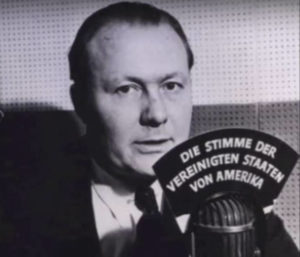When I started researching material for my book, The French Desk – A Brooklyn Gal’s Journey into Wartime Propaganda, I pulled my mother’s personnel file from the US Department of State to better understand her war work history. Much to my delight, all her previous jobs were listed. As I read through the file, I came to the realization that radio and my mother were not only great friends, as I detailed in Part 1 of this series, but also old colleagues.

Long story short, my mother attended the Katharine Gibbs School right after college because she did not want to be a nurse, teacher or lawyer at that time. There weren’t many career opportunities for women college graduates in the late 1930’s beyond the traditional routes. Even law school was unusual for a woman them, but not unheard of. In fact, the following year, her sister did go to law school right after college. What my mother really wanted to do was get back to Paris and work as a linguist but just how she would do that was not clear to anyone. In 1939, the war was escalating quickly so the thought of traveling to Paris was out of the question at the moment. Case closed.
Her father insisted that all his children be able to support themselves. Like many her age, I think she went to Katie Gibbs not out of desperation, but due to the lack of real opportunity for a smart, college-educated, French-speaking woman. Her stepmother also had gone to secretarial school and had an excellent career as an Executive Secretary before marrying my grandfather. “They’ll figure out you’re smart and will move you along,” my grandfather had said. How right he was!
Anyway, in the file, I saw that she started working in 1940, as secretary to the Radio Manager for Curtis-Brown Literary Agents. It was one of the most powerful agencies in its day, with an elite list of authors including D.H. Lawrence, C.S. Lewis, Daphne du Maurier, Winston Churchill, Theodore Dreiser, Ayn Rand and Ogden Nash. They must have had a radio show talking about their newest books. After a year, she left this job because there was “no opportunity.” Not sure what that comment meant, but this might have been the boss who yelled at everyone all the time, and my mother felt life was too short for all that.
By now, she had contacts in the radio world. Her next position was at the Coordinator of International Broadcast, working as the secretary to Stanley P. Richardson, the Coordinator. It was a division of the broader Office of the Coordinator of Inter-American Affairs which was established in August 1940 as a public / private partnership (with Westinghouse, GE, Crosley, CBS, and NBC) to combat German and Italian propaganda in South America, which was being flooded with anti-western / anti-democratic content.
After only a year, however, the office was disbanded. The communications professionals, the politicians, the military and the diplomats all realized they needed to broaden the US radio plan with an over-arching propaganda effort to counter the vast Nazi and other Axis programs. They knew they needed a worldwide propaganda platform even before Pearl Harbor.
By mid-1941, FDR hired William (“Wild Bill”) Donovan to create a US-version of the highly successful British SOE (Specials Operations Executive) – called the Office of Coordinator of Information (COI). Donovan hired Robert E. Sherwood, who was a well-known playwright and one of President Franklin Roosevelt’s speechwriters. Sherwood convinced Donovan of the need to set up a targeted propaganda agency, which led to the founding of the Foreign Information Service (FIS) to supply coordinated war news and commentary to the privately owned commercial short-wave radio stations and networks throughout the US, which was used on a voluntary basis. Beginning with the week after the attack at Pearl Harbor, the FIS began to supply direct programming. It was no longer voluntary.
The very first Voice of America (VOA) broadcast came one week after the attack on Pearl from the FIS San Francisco office to the Philippines in English. It took a few months to begin broadcasting to Germany, which began on February 1, 1942. The song The Battle Hymn of the Republic led off the show, which was called “Stimmen aus Amerika,” or “Voices from America.”
By mid-1942, the US government consolidated the many threads of its “white” information / propaganda initiatives, including the VOA, under the aegis of the Office of War Information. The Office of Strategic Services was also created at the same time to handle the ‘black’ propaganda, which included special operations like sabotage, misinformation and military-style initiatives which would be better handled by special operatives. In the run-up to the D-Day landings, the OWI Psychological Warfare Branch created an additional radio station, the American Broadcasting Station in Europe (ABSIE), which my mother was heavily involved with. More on that in another post.
Bonus nugget: Robert Sherwood is the creator of the station’s name, the “Voice of America.” The Voice of America (VOA) continues today. Here is a two-minute clip from May 22, 2020.
Nota Bene: To view Part I of this post, click here.
